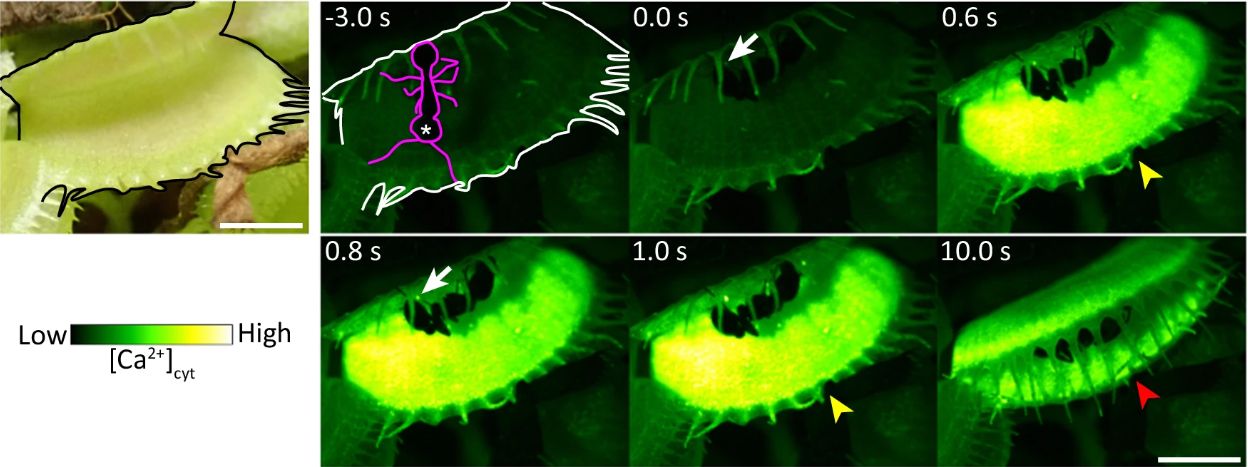Science
New Mechanosensor Revealed in Venus Flytrap’s Quick Responses

Recent research has unveiled critical insights into the rapid response mechanisms of the Venus flytrap (Dionaea muscipula). A study published in Nature Communications by a team led by Hiraku Suda identifies a mechanosensor known as DmMSL10, essential for the plant’s ability to detect prey through touch. This discovery enhances our understanding of how carnivorous plants have evolved to capture unsuspecting insects.
The Venus flytrap employs a unique spring-loaded mechanism to ensnare its prey. Unlike other carnivorous plants such as the waterwheel plant (Aldrovanda vesiculosa) that exhibit slower responses, the Venus flytrap can react in mere seconds. A notable exception is D. glanduligera, which has demonstrated a similarly rapid response. Despite previous knowledge of calcium threshold signals in these plants, the specific mechanisms remained unclear until this recent study.
The researchers created a version of the Venus flytrap lacking the DmMSL10 mechanosensor. This stretch-activated chloride ion (Cl–) channel plays a crucial role in the plant’s sensitivity to touch. While both the wild-type and knockout variants of the plant generated calcium ion responses, the knockout variant exhibited a significantly reduced rate of action potential generation. In contrast, the wild-type continued to produce action potentials even after stimulation had ceased, underscoring the importance of DmMSL10 in detecting subtle stimuli.
To further illustrate the functionality of this mechanosensor, the researchers conducted an experiment involving ants placed on the leaves of both the wild-type and knockout plants. The wild-type successfully captured the first ant that ventured onto its leaf, while the knockout variant failed to respond, with four ants unable to trigger the necessary calcium signals to close the trap. This striking difference demonstrates how critical DmMSL10 is for the Venus flytrap’s predatory efficiency.
This research not only elucidates the mechanisms behind the rapid movements of Dionaea muscipula but also raises intriguing questions about the evolutionary pathways that link plant and animal sensory responses. Understanding how plants like the Venus flytrap developed these mechanisms could provide deeper insights into the evolutionary adaptations that allow different species to interact with their environments.
As scientists continue to explore these fascinating adaptations, the findings from this study pave the way for future research into how mechanosensors evolved in parallel with similar systems in animals. The intricate dance of plant and prey remains a captivating area of study within the realms of botany and evolutionary biology.
-

 Business4 days ago
Business4 days agoInvestors Eye Potential $60,000 Gains with Ozak AI Token
-

 Politics5 days ago
Politics5 days agoFormer Pastor Arrested on Human Trafficking and Indecent Charges
-

 Business5 days ago
Business5 days agoQuotient Wealth Partners Adjusts Holdings in iShares Russell 1000 ETF
-

 Lifestyle5 days ago
Lifestyle5 days agoNatty from KISS OF LIFE Stuns in Micro-Shorts at Seoul Event
-

 Politics4 days ago
Politics4 days agoSkip Bayless Critiques Travis Hunter’s Game Day Baptism
-

 Business5 days ago
Business5 days agoCalifornia to Ban All Plastic Bags in Grocery Stores by 2026
-

 Entertainment5 days ago
Entertainment5 days agoUtah Residents Face Resource Shortages Amid Ongoing Government Shutdown
-

 Entertainment5 days ago
Entertainment5 days agoPete Davidson Surprises Pregnant Girlfriend with Private Jet to Concert
-

 Entertainment5 days ago
Entertainment5 days agoAce Frehley, KISS Guitarist, Passes Away at 74 After Fall
-

 Politics5 days ago
Politics5 days agoIberia Parish Sees Surge in Marriage Licenses Issued in October
-

 Science5 days ago
Science5 days agoCommunity Mourns Loss of Judith Ernst, Pioneer Educator at 81
-

 Entertainment6 days ago
Entertainment6 days agoEastside Kings Festival Celebrates Austin’s Rich Blues and Jazz Heritage









